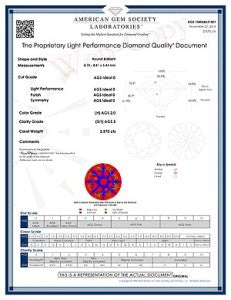
AGS Negligible Fluorescence vs GIA None
Based upon the number of questions that we receive per month regarding the difference between the fluorescence ratings of AGS Negligible versus GIA None, we thought that it would be a good idea to take a moment to explain the difference between diamonds with fluorescence ratings of GIA None and AGS Negligible.
The fact of the matter is that diamonds which are graded as having a fluorescence rating of GIA None and AGS Negligible are essentially the same thing… it’s just that the GIA uses the term “none” to describe diamonds which exhibit no fluorescence, to those which might exhibit a hint of fluorescence, but which do not exhibit fluorescence strong enough to be considered faint.
 While the American Gem Society Laboratory (AGSL) prefers the term “negligible” to describe diamonds which exhibit a level of fluorescence that is anywhere from “none” or so “insignificant” that it is not worthy of consideration… And in reality, the term “negligible” would be a more suitable term for the GIA Gem Trade Laboratory to use as well, since the diamonds which they refer to as having no fluorescence, sometimes exhibit insignificant amounts of fluorescence, which mean that they exhibit some fluorescence, so the term “none” is actually inaccurate, while the term “negligible” would be appropriate. Since the ratings of AGS Negligible and GIA None are essentially the same thing, the reality is that could have sent this 2.57 carat, H-color, SI-1 clarity, Brian Gavin Signature round diamond to either lab and the fluorescence rating would be essentially the same.
While the American Gem Society Laboratory (AGSL) prefers the term “negligible” to describe diamonds which exhibit a level of fluorescence that is anywhere from “none” or so “insignificant” that it is not worthy of consideration… And in reality, the term “negligible” would be a more suitable term for the GIA Gem Trade Laboratory to use as well, since the diamonds which they refer to as having no fluorescence, sometimes exhibit insignificant amounts of fluorescence, which mean that they exhibit some fluorescence, so the term “none” is actually inaccurate, while the term “negligible” would be appropriate. Since the ratings of AGS Negligible and GIA None are essentially the same thing, the reality is that could have sent this 2.57 carat, H-color, SI-1 clarity, Brian Gavin Signature round diamond to either lab and the fluorescence rating would be essentially the same.
AGS Faint Fluorescence vs GIA Faint Fluorescence ratings:
While the American Gem Society Laboratory and the GIA Gem Trade Laboratory use different terms to describe the same level of fluorescence that falls within the realm between none to negligible, both gemological laboratories seem to agree on their use of the term faint as it applies to diamonds with fluorescence.
The term Faint is used to describe diamonds where the degree of fluorescence is so slight that it is extremely difficult to distinguish when the diamond is viewed under the controlled light source provided by a diamond grading light, which is equipped with a black light, when viewed from a side profile in a room which is essentially completely dark, with exception of the light being provided by the diamond grading light.
If the color of the fluorescence is blue, then the fluorescence rating will simply indicate that the fluorescence level is faint; however if the color of fluorescence is anything other than blue, e.g. white, yellow, green, or another color, then the fluorescence rating will include the word faint and the color of fluorescence.
Faint fluorescence is not likely to have any effect upon the visual properties of a diamond, and is thus considered to be nothing more than an identifying characteristic, which can be used to help identify the diamond when being compared to another diamond with similar characteristics.
Unlike fluorescent levels of medium to strong blue fluorescence and even very strong blue fluorescence, the presence of faint blue fluorescence within a diamond does not command any sort of discount, nor does it invoke a premium, because it is only an identifying characteristic.




















